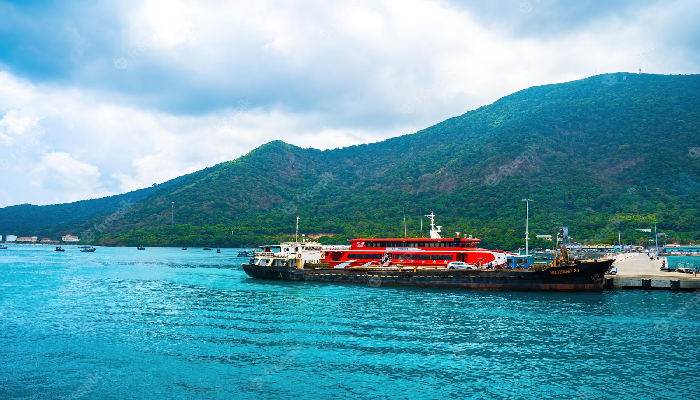Description:Vietnam offers a captivating blend of natural beauty, rich history, and vibrant culture. From exploring ancient temples and cruising through breathtaking landscapes to indulging in delicious cuisine and connecting with warm-hearted locals, Vietnam has something to offer every traveler. With proper preparation, an open mind, and a sense of adventure, you’re bound to create unforgettable memories in this fascinating country. So, pack your bags, embrace the chaos, and embark on an extraordinary journey through the land of contrasts – Vietnam!
Travel Vietnam: Exploring the Land of Contrasts
Vietnam is a country of contrasts, where ancient traditions blend seamlessly with modernity. From the bustling cities to the serene countryside, this Southeast Asian gem offers a plethora of experiences for travelers. Vietnam has something for everyone. In this article, The pros and cons of traveling to Vietnam are listed and we provide essential travel tips, and even explore the fascinating history of Vietnamese women’s hairstyles. So, let’s embark on a journey through the vibrant land of Vietnam!
Pros and Cons of Traveling to Vietnam
Pros
1. Rich History and Culture
Vietnam boasts a fascinating history that dates back thousands of years. From the ancient Dong Son culture to the colonial period under French rule, the country has been shaped by various influences. Exploring historical sites such as the Imperial City of Hue and the Cu Chi Tunnels in Ho Chi Minh City allows travelers to immerse themselves in Vietnam’s vibrant past.
2. Breathtaking Natural Beauty
With its stunning landscapes, Vietnam offers a visual feast for nature enthusiasts. From the limestone karsts of Halong Bay to the terraced rice fields of Sapa, the country is a paradise for photographers and outdoor adventurers. Don’t miss the opportunity to explore the hidden gem of Bai Tu Long Bay, which offers equally mesmerizing scenery without the crowds of Halong Bay.
3. Delicious Vietnamese Cuisine
Vietnamese cuisine is renowned worldwide for its fresh ingredients, bold flavors, and diverse regional specialties. From the iconic pho to banh mi sandwiches and fresh spring rolls, food lovers will be in heaven exploring the local street food stalls and vibrant markets. Don’t forget to pair your meal with a strong cup of Vietnamese coffee, a staple of the local culture.
Cons
1. Scams and Petty Crimes
Like any popular tourist destination, Vietnam has its fair share of scams and petty crimes targeting unsuspecting travelers. Be cautious of unlicensed taxi drivers and pickpockets in crowded areas. Always use licensed taxis and keep a close eye on your belongings. Additionally, be wary of tourist attraction scams and rely on reputable tour operators to book your adventures.
2. Haggling Culture
Haggling is a common practice in Vietnam, especially in markets and shops. While some travelers enjoy the thrill of bargaining for a good deal, others may find it overwhelming or uncomfortable. If you’re not accustomed to haggling, seek advice from your tour operator to ensure you’re not being taken advantage of. Embrace the opportunity to experience local customs and score a bargain!
3. Chaotic Traffic
Vietnam’s cities, particularly Hanoi and Ho Chi Minh City, are notorious for their chaotic traffic. Motorbikes dominate the streets, and crossing the road can be a nerve-wracking experience. However, with confidence and some caution, you’ll soon learn to navigate through the sea of motorbikes. Embrace the unique energy of Vietnamese traffic and keep an eye out for interesting sights, like locals carrying unusual packages on their bikes.
Travel Essentials and Tips
Best Time to Visit
Vietnam’s climate varies from region to region, so the best time to visit depends on your preferred activities and destinations. Generally, the months of November to April offer the most pleasant weather, with cooler temperatures and less rainfall. However, if you’re planning to explore the northern mountainous areas, such as Sapa, during the rice harvest season, September and October are ideal.
Visa Requirements
Most visitors to Vietnam require a visa, with a few exceptions for citizens of certain countries. It’s essential to check the latest visa regulations before your trip. You can obtain a visa in advance from your nearest Vietnamese embassy or consulate, or you can apply for an e-visa online. Make sure your passport is valid for at least six months beyond your planned departure date.
Currency and Money Matters
The official currency of Vietnam is the Vietnamese Dong (VND). While some establishments may accept major foreign currencies, it’s advisable to have local currency for smaller transactions. ATMs are widely available in cities and tourist areas, allowing you to withdraw cash in Vietnamese Dong. Credit cards are also accepted in many hotels, restaurants, and shops, but it’s always good to have some cash on hand for smaller vendors and street food stalls.
Health and Safety
Before traveling to Vietnam, it’s recommended to consult your doctor regarding necessary vaccinations and health precautions. Mosquito-borne diseases, such as dengue fever and malaria, are a concern in some regions, so take appropriate measures to protect yourself, such as using insect repellent and wearing long sleeves and pants. It’s also wise to have travel insurance that covers medical emergencies.
Transportation
Getting around Vietnam is relatively easy, thanks to its well-connected transportation system. Domestic flights are convenient for long distances, while trains and buses are popular for shorter journeys. In cities, taxis and ride-hailing services like Grab are widely available. For a unique experience, consider renting a motorbike to explore the countryside, but make sure you have the necessary license and insurance.
Respect Local Customs and Traditions
Vietnamese culture is deeply rooted in traditions and customs that may differ from your own. It’s important to respect local customs, such as removing your shoes when entering temples or someone’s home. Modest attire is appreciated when visiting religious sites. Remember to ask for permission before taking photos of individuals, particularly ethnic minorities, and be mindful of cultural sensitivities.
Language and Communication
The official language of Vietnam is Vietnamese, but English is widely spoken in tourist areas and by younger generations. Learning a few basic Vietnamese phrases, such as greetings and thank you, can go a long way in connecting with locals and showing respect for their culture. Having a translation app or a pocket dictionary can also be helpful for communication.
Stay Connected
Staying connected while traveling in Vietnam is essential for navigation, communication, and sharing your experiences. Wi-Fi is available in most hotels, cafes, and restaurants, but it’s advisable to have a local SIM card with data for convenience. SIM cards can be purchased at the airport or from mobile network providers throughout the country.
Stay Hydrated and Practice Food Safety
Staying hydrated is crucial in Vietnam’s tropical climate, especially during hot and humid months. Carry a reusable water bottle and drink purified or bottled water. When it comes to food, enjoy the local cuisine but be mindful of food safety. Opt for freshly cooked meals from clean establishments, and avoid consuming raw or undercooked food.
Pack Accordingly
Vietnam’s climate can vary, so pack accordingly based on the regions and seasons you plan to visit. Lightweight, breathable clothing is suitable for most of the year, but bring a light jacket or sweater for cooler evenings or mountainous areas. Don’t forget essentials like sunscreen, insect repellent, comfortable walking shoes, and a hat to protect yourself from the sun.
What To Do in Vietnam
Explore Hanoi’s Old Quarter
Start your journey in Vietnam’s capital city, Hanoi, and dive into the vibrant chaos of the Old Quarter. Wander through its narrow streets filled with colorful colonial buildings, street food vendors, and bustling markets. Don’t miss landmarks like the Hoan Kiem Lake and the Temple of Literature. Take a traditional cyclo ride and immerse yourself in the city’s rich history and culture.
Cruise Through Halong Bay
A trip to Vietnam wouldn’t be complete without a cruise through the iconic Halong Bay. Marvel at the breathtaking limestone karsts rising from turquoise waters as you sail through the bay’s maze of islands. Explore hidden caves, go kayaking, or simply relax on the deck and soak in the stunning scenery. For a less crowded alternative, consider Bai Tu Long Bay, which offers equally mesmerizing landscapes.
Visit the Ancient Town of Hoi An
Step back in time and explore the enchanting ancient town of Hoi An. This UNESCO World Heritage site is known for its well-preserved architecture, colorful lanterns, and narrow streets filled with tailor shops and art galleries. Take a leisurely stroll along the Thu Bon River, visit the Japanese Covered Bridge, and indulge in the town’s delectable cuisine. Don’t miss the Lantern Festival during Tết (Vietnamese New Year) for a truly magical experience.
Discover the Mekong Delta
Experience the vibrant life of the Mekong Delta, often referred to as Vietnam’s “rice bowl.” Cruise along the river’s intricate network of canals, visit floating markets, and witness the daily activities of locals. Explore lush fruit orchards, sample tropical fruits, and savor authentic regional dishes. Immerse yourself in the tranquility of the countryside and learn about the unique way of life in this fertile region.
Trek through Sapa’s Rice Terraces
Escape the bustling cities and embark on a trekking adventure through Sapa’s breathtaking rice terraces. Marvel at the terraced fields cascading down the mountainside, creating a mesmerizing tapestry of green hues. Engage with ethnic minority communities, such as the Hmong and Dao people, and gain insight into their rich cultural traditions. Don’t forget to capture the stunning landscapes that make Sapa a photographer’s paradise.
Learn about Vietnam’s War History
Vietnam’s turbulent history during the Vietnam War is a significant part of its identity. Gain a deeper understanding of this chapter by visiting historical sites like the War Remnants Museum in Ho Chi Minh City and the Cu Chi Tunnels, an intricate underground network used by the Viet Cong. Take a guided tour to learn about the war’s impact on the country and hear stories from locals who lived through that era.
Relax on the Beaches
Vietnam is home to some of Southeast Asia’s most beautiful beaches. From the pristine white sands of Phu Quoc Island to the vibrant coastal town of Nha Trang, beach lovers will find their slice of paradise. Enjoy water sports, go snorkeling or diving, or simply unwind on the golden shores. For a quieter beach experience, head to the charming town of Hoi An and explore its nearby beaches.
Indulge in Vietnamese Cuisine
Vietnamese cuisine is a highlight of any trip to Vietnam. Embark on a culinary journey and savor the diverse flavors of the country’s regional specialties. From the renowned pho noodle soup to the flavorful banh mi sandwiches, each dish tells a story of Vietnam’s culinary heritage. Take a cooking class to learn the art of Vietnamese cuisine and bring home the recipes to recreate the flavors of Vietnam in your own kitchen.
Experience Vietnamese Traditional Performances
Immerse yourself in Vietnam’s rich cultural heritage by attending traditional performances. Watch a water puppet show in Hanoi, where intricately crafted puppets dance on the surface of a pool, accompanied by live traditional music. Experience the mesmerizing beauty of traditional Vietnamese music and dance performances, such as the “ao dai” (traditional long dress) fashion show.
Engage with Local Communities
One of the most rewarding aspects of traveling in Vietnam is connecting with the warm and friendly locals. Engage in conversations, learn about their daily lives, and gain insights into their traditions and customs. Consider volunteering or participating in community-based tourism initiatives to support local communities and contribute to sustainable tourism practices.
The Evolution of Vietnamese Women’s Hairstyles
Vietnamese women have always taken pride in their smooth, black hair, which has been a symbol of beauty and femininity throughout history. Nicole Hudson Hair will take us on a journey through the changing hairstyles of Vietnamese women:
The Late Nineteenth Century
In the late nineteenth century, Vietnamese women’s hairstyles were characterized by neat styles and centered curves. Women in the northern regions would often tie their hair with a towel, leaving a short curly tail on one side of their face. The use of strap tassels hats and conical hats was also prevalent, serving as protection from rain and sunlight.
The Early Twentieth Century
In the early twentieth century, Vietnamese women’s hairstyles saw minor changes. The bun, instead of being around the head, was worn lower down to the nape. Different hairstyles were observed among the elite class, with the governor’s wife of Ha Dong province sporting a bun down to the nape.
The 1940s
In the 1940s, Hanoi women continued their hair traditions, but strap tassels hats became less common. Western influences started to seep into Vietnamese fashion, with women opting for bare buns to showcase their beauty. Brushed hair, curly hair, and short hair became popular, reflecting the modern fashion trends of the time.
The 1950s
In the 1950s, Vietnamese women’s hairstyles retained their classical essence but became more charming and feminine. Middle-aged women stuck to traditional tufts, while the bun gained more momentum, covering the back of the neck. Saigon women embraced a more liberal approach to hair, experimenting with different styles, curls, and shorter cuts.
The 1960s
The 1960s witnessed the rise of short hair among Vietnamese women. Short hairstyles, reaching the ears, became increasingly popular, and women confidently expressed their personalities through their hair. Bare-breasted girls riding bicycles with short hair became a common sight in Saigon, showcasing the changing fashion trends and the evolving role of women in society.
The 1970s
In the 1970s, Vietnamese women’s hairstyles continued to evolve, with minor changes from the previous decade. Curly and liberal hair remained popular, reflecting a more natural and carefree approach to beauty. The classic hairstyles were maintained but adapted to the modern era, showcasing Vietnamese women’s resilience and adaptability.
Present Day
In the twenty-first century, Vietnamese women’s hairstyles have embraced diverse trends and personal expressions. The restrictions of the past have given way to individuality and creativity. From long, flowing locks to bold and edgy cuts, Vietnamese women now have the freedom to explore various hairstyles that reflect their unique personalities and fashion preferences.







